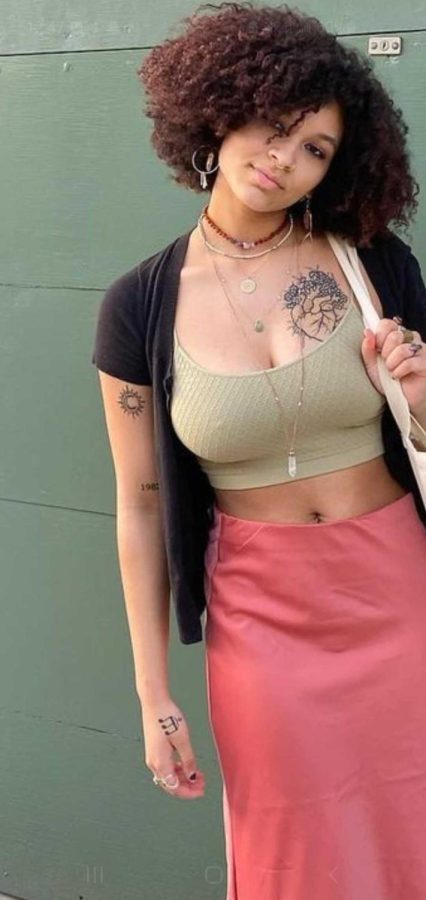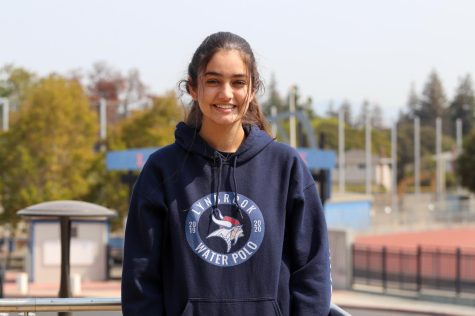Viking bodies become canvases for personality
Photo used with permission of Skye Amani
Tattoos have evolved into a way for people to express themselves and recognize important symbols in their life.
May 3, 2022
As the stigma against them declines, tattoos have become more common among young adults. Once a taboo activity, getting a tattoo was seen as rebellious, antisocial and the mark of an outcast. Tattoos have evolved into a way for people to express themselves and recognize important symbols in their life. Although most Lynbrook students are not yet 18, some have made plans to get tattoos later on and started planning possible designs. Three seniors at Lynbrook with tattoos are Manya Marri, Skye Amani and Tammi Trujillo.
In California, one must be at least 18 years old in order to receive a tattoo as getting one is a permanent decision. Students need to wait until they are 18 to get one professionally done by a tattoo artist. However, a recent trend for students under 18 is to take a risk to create their own using the stick-and-poke method.
Although the impulse to get started on a tattoo collection is tempting, all three seniors advise against stick-and-poke tattoos for students under 18. They never look as clean as professionally done ones and have a high chance of infection.
Marri’s interest started with stick-and-poke designs, homemade tattoos made with needle and ink. By the time Marri turned 18 in February 2021 and was ready to get a formal parlor tattoo, she had already gotten five tiny stick-and-poke tattoos done. It was completely different getting the large tattoo professionally done when she was legal.
“It hurt so badly!” Marri said. “The small ones didn’t hurt, but this one was my entire back so I felt like I was dying for almost three hours. They also had to go back over everything they already tattooed at the end to make sure it looked clean — that part was the absolute worst.”
Amani, who decided to get a tattoo done after her 18th birthday, experiments with a unique method to avoid most of the pain for her tattoos.
“I put numbing cream on before I got my tattoo, and I couldn’t feel anything for a good 45 minutes,” Amani said. “After it wore off, it really hurt but it was bearable knowing it was almost done.”
Numbing cream has its own benefits and tradeoffs, and ultimately, it is up to each individual to evaluate their pain tolerance in the specific part of the body they want tattooed.
After getting the tattoo, the aftercare to ensure the skin heals properly is a temporary but demanding process. This includes washing with antimicrobial soap and water one to two times a day and applying antibacterial or Vaseline ointment twice a day.
“After getting such a large tattoo, it was really hard to do the aftercare for it,” Marri said. “There was a lot of scabbing and it was super itchy.”
Marri wanted a way to recognize important parts of herself and events in her life through the art form of tattoos. Her first tattoo of a small moon was the start of her collection.
“I got my first tattoo after I really accepted myself and my personality,” Marri said., “ It’s small and simple so I know I will never regret it.”
While Marri got her tattoo as a way to express her personality through art, Trujillo chose some of her designs to honor her older sister.
“I got my snake tattoo because my sister planned to get it when she turned 18,” Trujillo said. “And the 13 was more sentimental because it was my sister’s soccer number and is my mom’s favorite number.”
Tattoos are often concealed and covered up due to parents not supporting them. Luckily for Amani, her parents supported all of her tattoos — she even has a few matching ones with her mom, like her triplet music note tattoo to attest to their love of music.
“My mom and I have a few matching tattoos,” Amani said. “Especially this anatomical heart one with flowers growing out of it, because we both have small heart conditions.”
Trujillo also has matching tattoos with her parents.
“We all have matching ‘kanji’ tattoos, which is my sister’s name, Rei, in Japanese, meaning light,” Trujillo said.
Marri, on the other hand, has only told her parents about one of her six tattoos.
“I have yet to tell my parents about the large one and most of the small ones,” Marri said. “They know about the moon on my shoulder and got so mad, but I get why. The depiction of a successful person doesn’t have tattoos, but I don’t think that should matter. ”
Regardless, all three seniors and many more students have plans to get more tattoos once they save up some money and find inspiration for their next design. They all hope to explore this art form further to commemorate events and parts of themselves.
“Getting tattoos is so therapeutic,” Marri said. “I feel so much better and alive after I get one. It’s probably the adrenaline rush but it makes me wanna get so many more in the future.”
While waiting to reach the age requirement for tattoos, students can contemplate important symbols in their life. When the time comes, this reflection will make a professionally done tattoo meaningful and beautiful.


































































